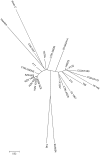Comparative genomic analysis of Mycobacterium tuberculosis drug resistant strains from Russia
- PMID: 23437175
- PMCID: PMC3577857
- DOI: 10.1371/journal.pone.0056577
Comparative genomic analysis of Mycobacterium tuberculosis drug resistant strains from Russia
Abstract
Tuberculosis caused by multidrug-resistant (MDR) and extensively drug-resistant (XDR) Mycobacterium tuberculosis (MTB) strains is a growing problem in many countries. The availability of the complete nucleotide sequences of several MTB genomes allows to use the comparative genomics as a tool to study the relationships of strains and differences in their evolutionary history including acquisition of drug-resistance. In our work, we sequenced three genomes of Russian MTB strains of different phenotypes--drug susceptible, MDR and XDR. Of them, MDR and XDR strains were collected in Tomsk (Siberia, Russia) during the local TB outbreak in 1998-1999 and belonged to rare KQ and KY families in accordance with IS6110 typing, which are considered endemic for Russia. Based on phylogenetic analysis, our isolates belonged to different genetic families, Beijing, Ural and LAM, which made the direct comparison of their genomes impossible. For this reason we performed their comparison in the broader context of all M. tuberculosis genomes available in GenBank. The list of unique individual non-synonymous SNPs for each sequenced isolate was formed by comparison with all SNPs detected within the same phylogenetic group. For further functional analysis, all proteins with unique SNPs were ascribed to 20 different functional classes based on Clusters of Orthologous Groups (COG). We have confirmed drug resistant status of our isolates that harbored almost all known drug-resistance associated mutations. Unique SNPs of an XDR isolate CTRI-4(XDR), belonging to a Beijing family were compared in more detail with SNPs of additional 14 Russian XDR strains of the same family. Only type specific mutations in genes of repair, replication and recombination system (COG category L) were found common within this group. Probably the other unique SNPs discovered in CTRI-4(XDR) may have an important role in adaptation of this microorganism to its surrounding and in escape from antituberculosis drugs treatment.
Conflict of interest statement
Figures



References
-
- World Health Organization (2010) Global tuberculosis control. WHO/HTM/TB/2010.7. Geneva, SW. Available: http://www.who.int/tb/publications/global_report/2010/en/index.html.
-
- The Federal Service for Surveillance of Consumer Rights Protection and Human Well-Being of the Russian Federation (2009) State Report “On the Sanitary-Epidemiological Situation in the Russian Federation in 2009”. Available: http://rospotrebnadzor.ru/documen/-/journal_content/56_INSTANCE_Zzk8/101....
-
- Keshavjee S, Gelmanova IY, Farmer PE, Mishustin SP, Strelis AK, et al. (2008) Treatment of extensively drug-resistant tuberculosis in Tomsk, Russia: a retrospective cohort study. Lancet 372: 1403–1409. Epub 2008 Aug 1422. - PubMed
-
- Punga VV, Jakubowiak WM, Danilova ID, Somova TR, Volchenkov GV, et al. (2009) Prevalence of extensively drug-resistant tuberculosis in Vladimir and Orel regions, Russia. Int J Tuberc Lung Dis 13: 1309–1312. - PubMed
-
- Toungoussova OS, Mariandyshev AO, Bjune G, Caugant DA, Sandven P (2005) Resistance of multidrug-resistant strains of Mycobacterium tuberculosis from the Archangel oblast, Russia, to second-line anti-tuberculosis drugs. Eur J Clin Microbiol Infect Dis 24: 202–206. - PubMed
Publication types
MeSH terms
Substances
Associated data
- Actions
LinkOut - more resources
Full Text Sources
Other Literature Sources
Molecular Biology Databases

